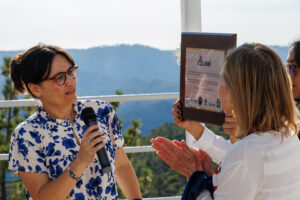COLIBRI on Arte, the Franco-German television station.
Arte Journal, Saturday, May 17, 2025.
Arte Journal, Saturday, May 17, 2025.
Our teams have made significant advances in commissioning of the DDRAGO instrument on the COLIBRÍ telescope. Although much remains to be done and there are important limitations, the telescope and instrument are already producing science-quality data.
Our medium-term plan is to have the telescope and instrument fully commissioned and operational before the start of the 2025B semester and to offer time to the Mexican and French communities through their respective Time Allocation Committees.
However, as we move towards this goal, and in consultation with INSU/CNRS and the Director of the Instituto de Astronomía, we have decided to offer early science time to our communities in a limited, shared-risk manner.
Some important points to consider are:
Proposers should prepare a 1-page request in PDF:
While both individuals and groups may send requests, each request should clearly indicate a single technical contact person and give their email address; all correspondence will be with this person.
French proposers should send their requests to the COLIBRÍ PI (Dr. Stéphane Basa, stephane.basa_AT_lam.fr).
These persons will forward the proposal to the science operations team. This team may communicate with the technical contact prior to the observations with advice or to seek clarifications. The team will also communicate with the technical contact when the data are available. If there is oversubscription, the science operations team will seek guidance from these persons.
In agreement with the MoU governing COLIBRÍ, the science operations team will treat the requests and data with professional confidentiality. They may examine the data to verify its quality and to characterize the instrument. They will not share the data outside of the science operations and instrument teams.
There is no requirement to include members of the science operations team as authors on any publication that results from these observations. However, we request that any publication cite the telescope and instrument papers and acknowledge the use of DDRAGO and COLIBRÍ; details are in the observing manual linked below.
The DDRAGO instrument is currently operating as a single-channel imager with a field of 26 arcmin, pixels of 0.38 arcsec, and g, r, i, gri, and B filters.
The transients team currently observes by taking 60 seconds exposures and dithering randomly in a circle of diameter 1 arcmin. This seems to give a good balance between efficiency, reaching the sky limit, being able to form a sky image, and not losing too much image quality to telescope tracking errors. Other strategies are possible, and one of the aims of this shared-risk time is to allow observers to determine the best strategies for their science and to communicate their requirements and experience to us.
We aim to keep individual observing blocks to about 30 minutes of real time (i.e., 24 x 60 second exposures plus overheads). If more data is required, we recommend repeating blocks.
A simple exposure time estimator is here.
A preliminary observing manual is here.
This manual will be updated as the instrument is commissioned.
The current state of the instrument is as follows:
The COLIBRI ground-based telescope unveiled its first images at its inauguration on September 7, 2024 at the San Pedro Mártir National Astronomical Observatory, Mexico. Designed as part of the SVOM space mission, the outstandingly fast telescope will be able to detect gamma-ray bursts, as well as other transient astronomical phenomena. The project is the result of close collaboration between France and Mexico, and is supported by the Aix-Marseille University, the CNRS, the French space agency CNES, the National Autonomous University of Mexico (UNAM), and Mexico’s National Council of Science and Technology.
The COLIBRI ground-based telescope has the remarkable ability to detect and record random flashes of light in the sky lasting just a few seconds. Designed as part of the SVOM space mission, whose goal is to identify and investigate gamma-ray bursts, this unique instrument, the only one of its kind in the world, will help astrophysicists to attempt to answer a host of questions relating to the study of transient astronomical phenomena, (such as the identification of the astrophysical objects at the origin of gravitational waves, and the sources of high-energy cosmic neutrinos), as well as helping them to understand the early Universe (in particular the identification of the first generation of stars and the study of the first galaxies).
Standing four metres high and weighing eight tonnes, COLIBRI can be pointed at any region of the sky in under 20 seconds. It is equipped with a 1.30 metre mirror and three cameras for simultaneous observations in the visible and infrared range. This robotic telescope carries out observations and surveys without human intervention, using an observation programme, thus further increasing its responsiveness and lowering operating costs.
To date, COLIBRI is the only astrophysics research facility jointly run by France and Mexico, and follows on from a long tradition of collaboration between the two countries, recently consolidated in the form of an International Research Project.
The telescope was fully assembled at the Observatoire de Haute-Provence and its performance tested through field trial for over a year before being shipped to Mexico. COLIBRI is installed at the San Pedro Mártir National Astronomical Observatory, Mexico, where it was inaugurated on September 7 and delivered its first images.


On Saturday 22 June, SVOM was successfully launched from the Xichang base in China. The rocket left at exactly the right second (15h local time) and the satellite is now operating at nominal levels.
COLIBRI has been specially developed for the SVOM mission, whose launch on June 22, 2024 is now imminent.